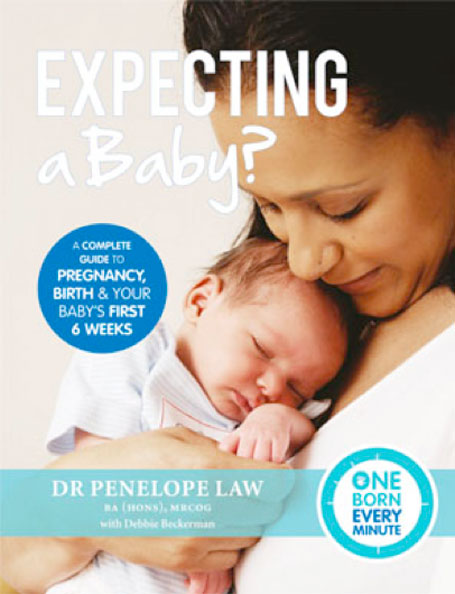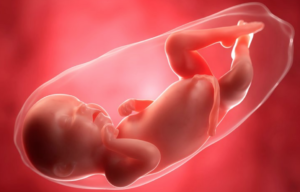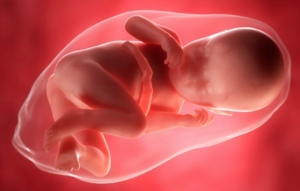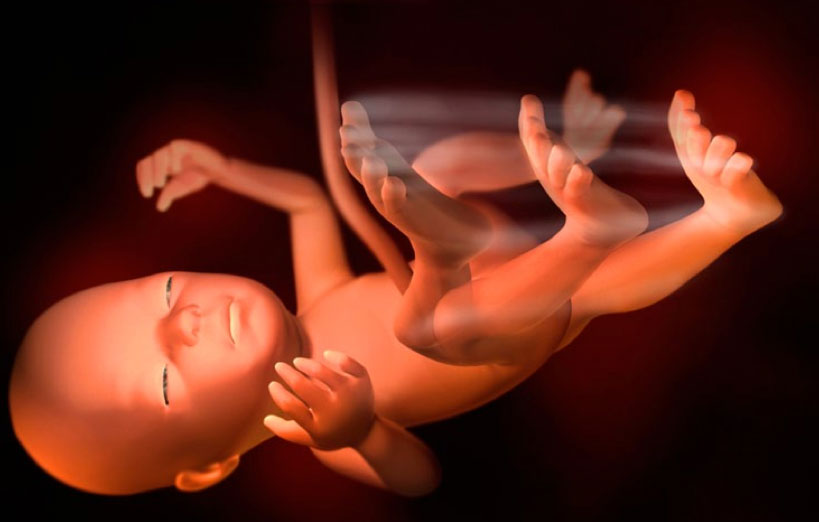Third Trimester

Reaching the third trimester is a significant milestone in your pregnancy. Now that all the main fetal systems are in place, all that is needed is time for them to mature. In the early weeks of this trimester the placenta continues to grow, though not as fast as the baby.
These last few weeks can be physically demanding: your lungs and other internal organs are becoming more compressed as the baby increases in size; your blood pressure is slightly more raised and any back pain you have been suffering from may increase in intensity. While your increasing size can give you discomfort, you can nevertheless start to look forward to your exciting new arrival.
Week 27
Your Baby
The brain is growing fast and, in order for it to fit inside the skull, the brain tissue now folds over itself so that, in cross section, it resembles a walnut. The fatty, protective myelin sheath that covers the nerves in the spinal cord now coats the brain’s nerve fibres, which leads to faster nerve impulses from the brain to the rest of the body.This results in fetal movements and reaction times that are much quicker and more sophisticated. Not only is there still sufficient space in the uterus for the fetus to move more (after about Week 30, your baby’s movements will gradually diminish as space becomes tighter), but its strong kicks, somersaults and changes of position are felt most strongly in this period. This is because less amniotic fluid is being produced than before, so its cushioning effect is reduced.
DID YOU KNOW…?
It is common for women to have vivid dreams throughout their pregnancy, especially during the last trimester.
No one really knows why this is so, but it is thought that dreams are a way to subconsciously deal with your fears and concerns about impending birth and motherhood.
You
The birth is still some way off, but you can keep your partner involved in your pregnancy by talking about your antenatal appointments when you have had one. Most partners will want to be present at the birth, but this is not always the case. It is a good idea to have someone to accompany you during labour – they are known as your ‘birthpartner’.If this is going to be someone other than the person you are in a relationship with, you could start thinking about who this might be, so that they can prepare themselves and attend antenatal classes with you, if necessary.
Start researching baby equipment (e.g. prams, cots) and whether there are any items that you could borrow
Week 28
Your Baby
Skin creases are visible on the hands and the eyes are fully open, blinking and are sufficiently sensitive to light that the fetus will turn away if a strong light is shined at your abdomen. The fetal lungs are maturing fast and lanugo and head hair are well developed. The amount of white fat increases to 3.5 per cent of body weight and smoothes out the wrinkles ontheskin.Toenails are visible,lagging behind the fingernail development by four weeks. The foetal length is 25 cm and the weight is about 1,000 g.
DID YOU KNOW…?
Between Weeks 28 and 30, the reflexes between the fetal taste buds and the facial muscles are sufficiently developed that if you eat a bitter-tasting substance, this can induce a grimace in the foetus
You
The bottom of the rib cage has started to arch out a little in order to create more space for the increasing size of the uterus. This can cause pain in the lower ribs, especially if you are of relatively small build. Heart palpitations (cardiac arrhythmia) can also arise at some point in the third trimester, which can feel very unpleasant, although they are not usually a sign of anything serious.
If a blood test taken at the start of your pregnancy has shown that you are Rhesus D positive, you will be given an ‘anti-D’ injection, either now or at any time up to 34 weeks.
Have another blood test for anaemia and glycosuria
Weeks 30-33
Your Baby
Week 30: Billions of neurons are forming daily in the growing fetal brain and their development is helped by a good maternal diet, especially one rich in proteins and in the essential fatty acids found in oily fish, nuts and seeds. Iron is also important, as the fetal bone marrow is now producing all the red blood cells, and stores of iron, as well as calcium, are being laid down in preparation for birth.
Week 31: More white fat is being deposited around the body, with the result that lanugo starts to thin out and may only remain on certain parts (although the fetus will still be covered in a thick layer of vernix caseosa). The hair on the scalp, however, continues to thicken. Between Weeks 28 and 32 the fetus gains around 500 g per week, and gradually looks a little plumper and less wrinkly. The skin is now pinker, because there is more fat to cover the blood vessels.
Week 32: Between Weeks 32 and 35, the fetal rate of growth slows to about 200 g per week. The eyes are able to focus to a distance of approximately 15–20 cm. In males, the testes continue to descend. By the end of this period, the skin is pink and smooth and the upper and lower limbs are more substantial. The foetal length is 28 cm and the weight is around 1,700 g.
Week 33: The brain and nervous systems are fully formed by Week 33 and lung maturation is such that a baby born now may only need minimal assistance in breathing. 
You
Week 30: Your diaphragm is becoming compressed and, by Week 30, when the fundus is at its maximum height of approximately 30 cm, it is flatter and more stretched out. This makes it less able to expand and contract as you breathe and, together with the compression of your lungs, means that for much of the trimester you will feel short of breath and/or will need to breathe deeply. The decrease in lung efficiency, as well as the increased progesterone levels that dilate your blood vessels, can make you feel light-headed and even faint on occasion.
Week 31: You may notice that your breasts continue to grow; on average, women have gained an extra 1 kg of breast tissue by now. If they have not already done so earlier, the breasts often start to leak colostrum, the yellowy-orange clear liquid that is the first milk you produce just after giving birth.
Week 32: Your abdomen has expanded so much that, in some women, their belly button now protrudes and is visible through clothing. You are likely to tire very easily from now, not helped by the difficulties in finding a comfortable position in which to sleep, so make sure you don’t overdo it and take as many opportunities as you can to rest in the final few weeks of your pregnancy, particularly if you are working or looking after other children.
Week 33: As your bump puts increasing pressure on your pelvic floor, you may find that you leak a little urine from time to time, especially if you laugh, cough or sneeze. This is called ‘stress incontinence’. If you haven’t already developed them, varicose veins and haemorrhoids are an unsightly and sometimes painful accompaniment to the later stage of pregnancy, although they almost always improve or disappear shortly after the birth.
Weeks 34-38
Your Baby
Week 34: Fingernails reach the end of the fingers, although this is not yet the case for toenails, which grow more slowly (as they do all through life: six months to grow a new fingernail, eight to twelve months for a toenail).
Week 35: The body is continuing to round out as fat accumulates under the skin. While this helps the fetus to regulate its body temperature, there is still not enough for a baby to keep warm outside the womb. Babies born now are therefore
likely to need to be placed in an incubator.
Week 36: This week also marks the stage at which the fetus has developed the full range of sucking movements. Babies born much before this time will have difficulty in sucking and swallowing, so the more premature they are, the longer it can take for them to learn to breastfeed (although, in time, these babies can and do breastfeed very successfully). The heart rate has slowed down further and, although a baby born at this stage would be referred to as premature, nearly all those that are born now do very well, can breathe unaided and rarely need to go to the neonatal unit.
Week 37: A baby born from now on would not, technically, be premature – just early – and would be unlikely to need any time in the neonatal unit unless there was an underlying health problem that had been detected prior to the birth or soon afterwards.
Week 38: The skull bones, although fully formed, are not fused and are soft enough to be able to slide over each other when the baby makes its way down the birth canal. Although the fetal lungs are now mature enough to breathe independently if your baby is born now, the alveoli are still primitive, and 95 per cent of the 300 million alveoli present in adult lungs develop after birth. 
You
Week 34: Many women (though by no means all) notice that their uterus hardens several times a day. These tightening sensations are called Braxton Hicks contractions, and they can start as early as the second trimester, although it is more common for them to begin during the third.
Week 35: Your blood volume increases again during this last trimester and reaches its maximum of approximately 5.4 litres by Week 35, an increase of over 50 per cent compared to your non-pregnant state. Plasma (the fluid element of blood) accounts for most of the increase, rather than the oxygen-carrying red blood cells – this is why anaemia is common in the third trimester of pregnancy.
Week 36: If this is your first baby, the head may start to ‘engage’ from now. This means it starts to move down into your pelvic cavity in anticipation of labour. If you are slow to engage and this is your first baby, you will probably be sent for an ultrasound scan to determine what the reason might be.
Week 37: Your pregnancy is considered ‘at term’. Although you will still notice large movements, you will be less able to feel the smaller ones. If you are finding that making frequent trips to the toilet at night is disturbing your sleep, try drinking plenty throughout the day the keep you hydrated, but drink less in the evenings. You may also find it more comfortable to sleep in an upright position.
Week 38: Your pregnancy is mature and your baby may be born any day now. Look out for the signs that labour may be imminent, which may include a ‘show’, the detachment of the mucus plug that seals the uterus. This is sometimes accompanied by light spotting, but if you experience any heavier or prolonged bleeding, contact your maternity unit immediately.

